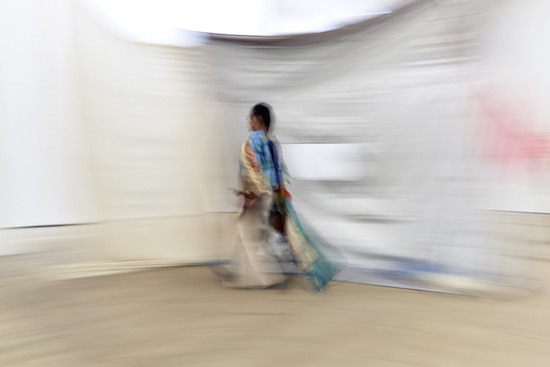“Why are we here?” Pedro Cabrita Reis asked Baltic director Sarah Munro over lunch on the day of the opening of the art centre’s inaugural Artists’ Award. Along with Lorna Simpson, Mike Nelson, and Monica Bonvicini, Reis had been invited to select just one artist each to receive the very first international artists’ award chosen by artists themselves. The award is part of Munro’s mission, since joining the Baltic some eighteen months ago, to emphasise the “centrality of artists”, as she put it in her speech at the opening, in every aspect of the institution’s work.
The centre’s third and fourth floors had been taken over by new large-scale works by Reis, Simpson, Nelson, and Bonvicini’s selected artists, Jose Dávila, Eric N. Mack, Toni Schmale, and Shen Xin, each of whom – in addition to being granted this major commission at one of Europe’s largest institutions for contemporary art – had been awarded £25,000 to create their work plus a fee of £5,000. The award, presented for the first time this year, represents a unique example of artists being offered the chance to act as patrons to their own peers and offer a leg up to younger artists whose work they esteem.
For the selected artists, it’s an extraordinary opportunity. But for the judges, too, it must feel like quite an honour, a singular vote of confidence in their judgement and taste. So quite naturally Reis found himself wondering, why us?
There’s an official answer to that question, of course, Munro said, and she could quote from various statements and press releases to detail the reasons given and explanations put forth. Reis, Simpson, Nelson, and Bonvicini are all highly regarded artists in their own right. Simpson has presented major solo shows at the Museum of Modern Art in New York, Denver Art Museum, and the Whitney Museum of American Art, and in 1990 became the first African-American woman to exhibit at the Venice Biennale. Nelson has also exhibited at Venice and been twice nominated for the Turner Prize (in 2001 and 2007). Bonvicini’s sculptures are on permanent display at Stratford’s Olympic Park and in the harbour of Oslo opera house and she was made a Commander of the Order of Merit by the Italian Republic in 2012. Reis himself is one of Portugal’s most famous artists, having represented his country at Venice, shown at Documenta and the Biennales of both Lyon and Sao Paulo. They’re all, also, artists with a firm relationship with the Baltic, with each of them having either given solo shows there in recent years or in the process of preparing one now.
Those are the official reasons, the ones you’ll find in prepared statements and official documents. But the real reason, Munro admitted, is “because you’re all dudes.”
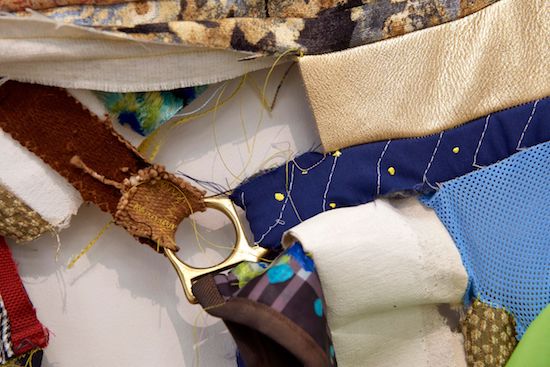
Eric N. Mack, in particular, seemed quite taken aback to be selected by Simpson, an artist he has personally respected for a long time. “It’s monumental,” he told me, as we stood in the shadow of his exhibition for the Award’s exhibition, to be so chosen by an artist with “such a dynamic trajectory.” Mack’s work acts directly on the fabric of old clothes, using dyes and bleaches to artfully disfigure items by Reebok (as well as less… recognised outfitters). But for Mack, shirts and slacks are just another form of canvas. “I still see the links to painting as being very strong,” he told me.
On the Baltic’s fourth floor, his pre-worn paintings (many of the clothes involved are old items from Mack’s own wardrobe) spill over from any possible frame, creating what he calls “slippages between the work and the space.” I don’t know your spirit. I make it up everyday from fragmentary portions(2017), for instance, uses the rough cotton of jogging bottoms and a vintage jacket stand in for the warp and weft of canvas, to be painted in a series of abstract brushstrokes in blue, green, and pink, spotted with yellow and purple dyes, to make an abstract composition shaped by the affordances of its surface. The potential of bleach, here sprayed liberally over the jacket’s sleeves, is explored as “a mark-making tool to create negative space.” But if his art work appears unruly, Mack confesses that his manner of thinking is “very formal and that opens up to the politics of the garment.” It’s a question of who gets to speak and who must remain silent, “the ownership of a particular kind of jacket.” It’s much easier for a spectator to imagine the fabric of canvas to be a neutral, depoliticised space – with old clothes, not so much.
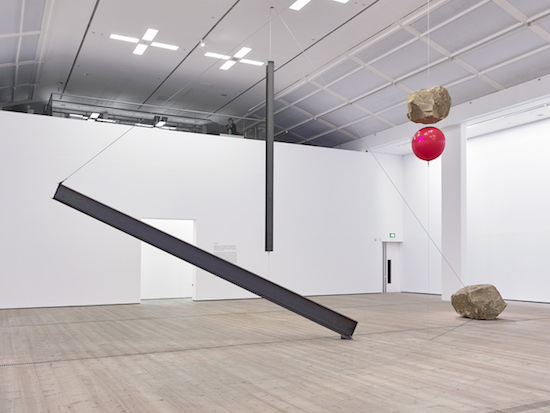
Sharing space with Mack in the fourth floor’s big main room is Mexican artist Jose Dávila and, like Mack’s, much of his work is suspended from the gallery’s impressively high ceiling – albeit with steel cables, not clothes lines. Probably for the best, since the things suspended are giant metal girders and sandstone builders. The weaker has conquered the stronger(2017) is, in Dávila’s words, “a physical poem” suspended in mid-air, in which two steel i-beams, a couple of big rocks, and one large red latex balloon (inspired, Dávila tells me, by Albert Lamorisse’s 1956 short film, Le Ballon Rouge) form a “closed system” in uneasy tension, threatening at any moment to teeter, topple, and collapse.
“It was important to have balance in the work,” Dávila said, “–not just physical balance, but conceptual balance, too.” As the title suggests, Dávila’s childlike balloon which seems to be effortlessly balancing a massive rock on its top, represents a triumph of hope over despair, of innocence over cynicism, of verticality over the spirit of gravity. Ever since he was a child, growing up in Guadalajara, Dávila has been fascinated by building sites. Later, he studied architecture. So to boulders and girders he’s no stranger. But it was important, he said, to balance all these “macho materials” with something more “joyful”, a little “element of hope”.
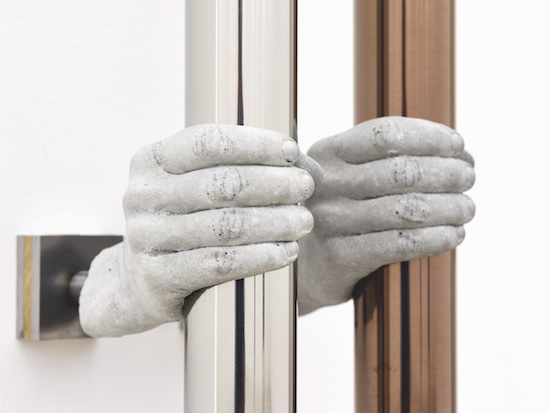
Toni Schmale regards the five works in her room on the third floor as a “family constellation” – complete with family dynamics inspired by the British psychoanalyst Donald Winnicott’s theory of “transitional objects.” A former professional footballer, Schmale’s object-family is comprised largely of a set of mute black sculptures, resembling equal parts gym equipment and torture devices. Each built around the same steel tubes, works like wildkatze (2016), the good enough mother (2017), dipstation (2017), and waltraud (2017) recall Sterling Ruby’s blackened domestic objects in their abstract impenetrability. But Schmale’s works have a distinctively rough, annealed texture, burnt onto their surface. This – and the temperature induced differences in colour in the two polished steel poles 170 grad and 400 grad (2017) – suggests the possibility of a new aesthetics of heat, of energy itself as an artistic material.
Ultimately the machine imagery of these works serves to conceal their absence of functionality. Asked how she went from the life of a professional athlete to becoming a professional artist, Schmale insisted “it’s not so far away.” Both, she said, required the same “passion”, the same “discipline”. There is one difference she would concede, though. “Before it was function, function, function,” she told me. “Now it’s more about dysfunction.”
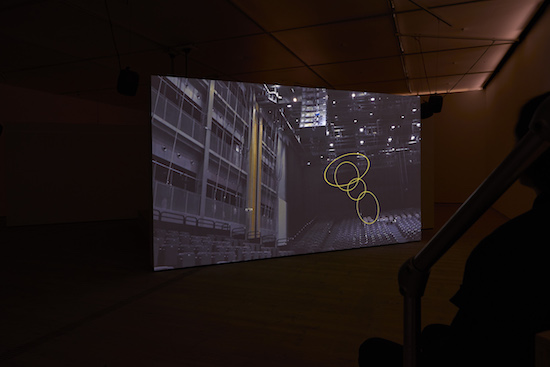
“The research for Provocation of the Nightingale started in 2015,” Shen Xin told me, regarding her contribution to the show, “when I started to look into the assimilation of religious practice in different cultural contexts, and my interests in how belief systems are constructed, and unfolded into the world.” In a darkened room at the far end of the third floor gallery space, Xin has erected four large screens, between which a complex narrative unfolds concerned with the nature of identity and power – and the tendency of both towards absolutism. “The work takes on the research of religious practices,” Xin said, “as well as the increasingly popularised DNA testing, biodata, and technology. And it is developed through a scripted narrative that reveals the subjects through love, found footage materials, performance and animation.”
Xin’s project is complex and hard to summarise in just a few sentences, but one aspect of the work that is immediately palpable is the way that it dramatises the gap between what we see and what we hear. As we watch a couple staring at each other, breathing heavily, across an empty stage, dubbed over with the sounds of wrestling or fighting, we catch a glimpse of the violence simmering unseen beneath social relations. As we see voices from YouTube confessing their surprise at DNA test results, animated in concentric rings representing the amplitude and frequency of the voice, we are offered a notion of a more supple definition of identity. All four videos take place against the backdrop of the auditorium at the Asia Cultural Centre, in Gwangju, South Korea. “The theatre space appealed to me as it is built to be reconstructed, through multiple units rising from the floor,” Xin explained.
“I was thinking of making works which allude to systems,” she continued, “which involves the considerations of spatial memories, in terms of how it is mapped out in the mind of the audiences while viewing the four different channels, as the channels are very different from each other in terms of how time is delivered. At the same time it is both the specific and abstract idea of subjects being staged, where performativity is constantly confronted throughout different materials in the film.”
"What’s not to like?" Mike Nelson replied, when I turned Pedro Cabrita Reis’s question back upon the judges and asked, why are you here? "I’m keen to support anything that gives opportunity and funding to an artist, especially when it can allow something to happen in an artist’s life that may not have done in an expected trajectory. As an artist, it certainly means something different to have affirmation and support from your peers as well as institutions." As Sarah Munro said in her address at the opening, "It’s not what you do – it’s how you do what you do."
The Baltic Artists’ Award exhibition is on display at the Baltic, Gateshead, until 1 October 2017

